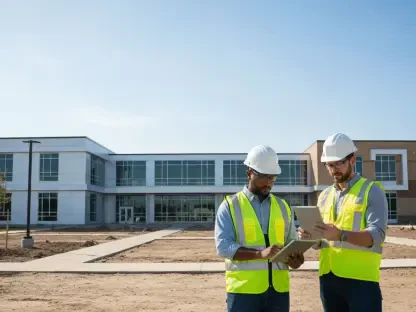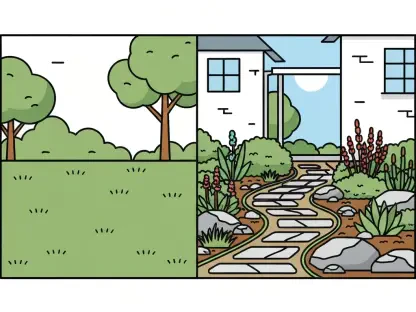Examining the landscape of sustainable construction in Canada, the complex web of awareness versus action comes into sharp focus. The challenge of fully integrating eco-friendly practices, despite high levels of awareness among industry stakeholders, reflects a need to bridge this gap and foster a more profound commitment to sustainable principles. This situation presents both a challenge and an opportunity, calling attention to the importance of addressing disparities and driving substantial progress in adopting sustainable construction techniques. As Canada grapples with its environmental self-image, the necessity of reconciling the pace of adoption with the pressing global need for sustainability becomes crucial.
Understanding the Global and Canadian Landscape
Amid escalating global challenges like urbanization and scarcity of resources, sustainable construction stands out as a vital solution, promising to alleviate environmental pressures while supporting urban growth. Worldwide, a considerable thrust towards sustainable construction practices signifies a conscientious response to the growing demand for environmentally responsible building solutions. Although Canada often presents itself as a pioneer in environmental stewardship, the actual pace of adopting sustainable construction suggests a disparity between perception and practice. This discrepancy serves as a poignant reminder of the urgent need to accelerate sustainable efforts, underscoring Canada’s lag in the face of innovative global movements.
Efforts across the globe mirror strategic advancements in sustainable construction, showcasing the necessity to not only embrace such practices but also intensify their application within the industry. In Canada, this reality accentuates a critical lag in both awareness and practical application, pointing to a heightened urgency to bridge this gap. The global momentum offers valuable lessons on integrating sustainable practices into construction paradigms, emphasizing the need for increased commitment and dynamic responses to meet Canada’s sustainable construction goals.
Awareness Disparities: A Closer Look
The issue of awareness emerges as a prominent hurdle in advancing sustainable construction within Canada. Although industry stakeholders increasingly recognize the importance of sustainable building practices, general public awareness remains critically low. This presents a significant challenge that hampers broader adoption, revealing a deep-seated gap that needs to be addressed through effective education and outreach strategies.
Public familiarity with sustainable construction concepts hovers at a mere 22%, highlighting the necessity for comprehensive educational campaigns and public engagement initiatives. Such efforts are indispensable in cultivating a deeper understanding of sustainable construction benefits and fostering widespread support. The need to engage citizens in conversations around environmental impacts and the significance of sustainable practices is crucial to driving change. The gap in awareness suggests that more stakeholders, beyond industry professionals, need to be involved in crafting and disseminating information aimed at elevating public comprehension.
Prioritization and Commitment Challenges
The challenge of commitment to sustainable construction practices reflects another layer of complexity within both global and Canadian contexts. Despite 69% of international stakeholders acknowledging sustainable construction as a priority, active and structured integration of these principles remains limited. This pattern echoes within Canada, where only 52% of individuals view it as a crucial element worth advocating for. The gap between recognizing the importance of sustainable practices and taking substantial steps toward their integration calls for deeper exploration and intervention.
Such statistics point to a pivotal area for growth, urging policymakers and industry leaders to foster more robust advocacy. Encouraging citizens to become active participants in sustainable initiatives can transform indifferent attitudes into powerful support systems, promoting comprehensive adoption. The path forward necessitates innovative strategies and policy frameworks that incentivize stakeholders and individuals alike. Clear pathways that align private interests with public priorities could lead to greater progress in sustainable construction efforts.
Driving Forces and Regional Strategies
Regional distinctions shape the strategies and priorities surrounding sustainable construction, informing the challenges and opportunities inherent in its adoption. In Canada and across North America, affordability stands as a notable factor influencing construction practices. This diverges from regions like Europe, where renovation and adaptation of existing structures claim prominence, indicating varied economic and environmental contexts driving regional priorities. Recognizing these distinctions aids in developing localized strategies that are both effective and responsive to the complexities of each region.
Embracing regional specificities allows for more tailored approaches to sustainable construction, factoring in the unique economic, environmental, and societal influences. For Canada, understanding affordability as a paramount concern can steer efforts toward providing accessible and cost-effective solutions, thereby nurturing broader acceptance and implementation. This necessitates crafting policies and initiatives that resonate with regional realities, ensuring sustainable practices globally address local needs and capabilities, fostering a harmonious balance in sustainability efforts across diverse communities.
Roles of Private Sectors and Policy
The private sector, particularly those involved in design and engineering, holds substantial sway in advancing sustainable construction. However, regional perceptions regarding their roles vary significantly, affecting the advancement of sustainability goals. The potential for these sectors to lead transformative changes is evident, yet realization requires clear policy directions and collaboration that mobilizes their strengths. Feedback from surveys suggests that strategic policy frameworks could effectively galvanize private sector engagement, positioning these players as key protagonists in the sustainable construction narrative.
Designing policies that leverage private sector expertise while aligning with national sustainability targets is vital. The role of policymakers extends beyond mere regulation; it is about fostering environments where innovation and sustainable design flourish. By encouraging collaboration across these sectors, a more robust, interdisciplinary approach to sustainable construction can be achieved, facilitating more rapid and effective adoption. Policies that articulate distinct goals and provide incentives can transform the existing landscape, turning potential into action and advancing Canada’s sustainable construction priorities.
Overarching Global Trends
A global consensus is emerging around the importance of sustainable construction, predominantly framed within environmental contexts such as energy efficiency and eco-friendly materials. Globally, there is recognition of the need to innovate and adapt, addressing unpredictable climate challenges that demand resilient construction solutions. Such focus propels advances in building technologies that mitigate environmental impacts and provide long-term solutions aligned with sustainable objectives. The consensus underscores a pivotal shift toward evolving construction practices to meet the demands of a changing environment.
Interestingly, the potential for sustainable construction to enhance occupant well-being remains underutilized, often overshadowed by environmental imperatives. This aspect presents an opportunity for growth, whereby integrating health-focused design can elevate the value of sustainable efforts. The inclusion of well-being in the construction dialogue, with equal emphasis on environmental goals, could redefine sustainable practices—positioning occupant health as an integral parameter of sustainable success and complementing efforts to mitigate climate impacts.
Educational Barriers and Growth
Education and training gaps represent considerable barriers to advancing sustainable construction practices. The complexity of these practices demands a thorough understanding, yet only a small percentage of professionals report feeling sufficiently informed to take decisive action. Bridging these gaps requires the integration of comprehensive, sustainability-focused curricula within educational institutions, extending knowledge beyond mere awareness to actionable expertise. Current and future industry professionals need access to training that equips them with the skills necessary to implement sustainable practices effectively.
A transformative approach that cultivates knowledgeable leaders can guide the transition from awareness to systemic change. Educational institutions need to prioritize emerging trends in sustainable construction, curating content that resonates with both existing industry needs and anticipated future demands. By nurturing informed professionals, the construction sector can align practice with principle, ensuring progress toward sustainability that is both immediate and far-reaching.
Tailoring to Local Contexts
In Canada, the realm of sustainable construction is a vivid illustration of the challenges tied to converting widespread awareness into tangible action. Many within the industry are well-informed about the benefits and necessity of eco-friendly practices, yet this awareness has not fully translated into widespread adoption. The gap between knowing and doing highlights a crucial need to foster stronger commitments to sustainable construction principles among stakeholders. This situation offers both a challenge and an opportunity. It’s an opportunity to push forward meaningful progress in using sustainable construction methods, which are essential in addressing environmental concerns. For Canada, a country with a strong environmental self-image, aligning the rate at which sustainable construction techniques are adopted with urgent global sustainability demands is of paramount importance. Bridging this divide involves addressing the disparities in the awareness-to-action transition, ultimately fostering a robust and genuine embrace of eco-conscious methods in the construction sector. Recognizing this critical junction, industry leaders, policymakers, and stakeholders need to collaborate and implement strategies that not only encourage but also facilitate the integration of sustainable practices more effectively across the board.









